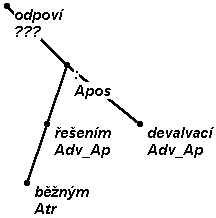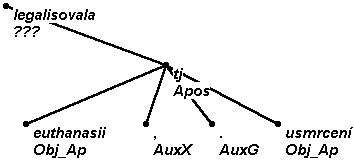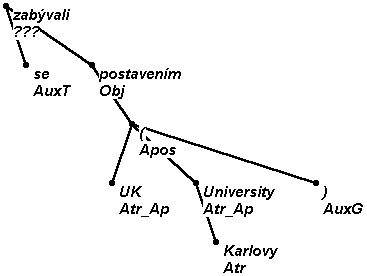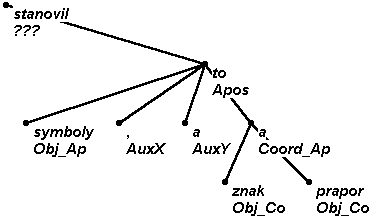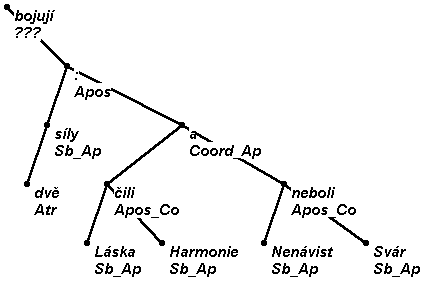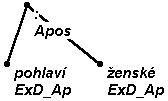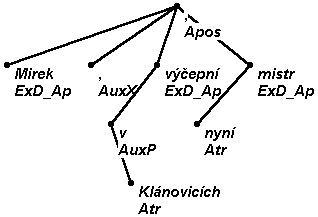After a specification of the function of apposition in the part Specification of apposition, we present an account of how apposition is formally treated in our scenario (part Representation of apposition). This part also contains a list of possible expressions that may introduce apposition. In the part Distinguishing apposition from other relations we attempt to differentiate apposition from other sentence relations with which it might be mistakenly interchanged (dependency, coordination or parenthesis).
Apposition is a relation that makes it possible to render the same 'idea' in several different ways. The members standing in apposition are the same sentence part, they usually are in the same case and they can be interchanged:
The condition requiring the same form (case) need not be met if the members in the apposition relation are adverbials, because the repertoire of the means for the expression of adverbials is very large:
We differ from Šmilauer's understanding in that our specification of apposition is narrower: we do not regard as apposition the types of “specializing” attribute (as e.g. rozinky sultánky raisins sultans, slečna sousedka miss neighbour, my Češi we Czechs, see Agreeing attribute expressed by a noun) and also adverbials as dole pod podlahou down below the floor, letos v únoru this year in February, nahoru na kopeček up to the hill (see Problematic cases of temporal modifications and Problems of local adverbial).
Similarly, we do not regard as apposition the case when seemingly apposited members have no place to be suspended on (the member for the assignment of afun Apos is missing, see below): nodes for such elements are suspended side by side, without apposition.
However, we do regard as apposition items in a questionnaire or list divided by a colon or by some other graphic symbol (see ex. (6) in the following part).
The following expressions are typical for introducing an apposition:
aneb, a sice, a tedy, a to, čili, jako, jako je, jako např., jako například, např., například, neboli, tak třeba, tedy, tj., to jest, to znamená, tzn.
The list is not (even cannot be) complete, i.e. apposition may be introduced by other expressions as well and the decision is up to the annotator. At the same time, an inclusion of an expression in this list does not necessarily mean that a presence of such an expression in a sentence always indicates that a relation of apposition is present.
In addition, apposition may be introduced by mere graphic symbols, such as comma, dash, colon, brackets.
According to the current conventions, apposition is represented in the tree structure in the same way as coordination, i.e. the respective means of expression are assigned the afun Apos and the members that stand in an apposition relation are suspended on this governing node; their afuns are composed from the label denoting their function (Sb, Obj, Atr, ...) and from the suffix _Ap.
When deciding which node is assigned afun Apos, the following rules hold:
-
If the connecting expression is a single node, then the situation is clear (see exx. (1), (6), (7)).
-
If the connecting expression is a word (or an abbreviation) preceded by a comma, the afun Apos is assigned to this word and the comma is suspended under it (exx. (2), (4)).
-
If the abbreviation is followed by (its) fullstop, the fullstop is suspended under the abbreviation (according to the rules of punctuation, see Punctuation marks after an abbreviation (fullstop), here ex. (2)).
-
If the means for apposition consists of a string of words, the last word in the string is the governor of the whole expression, other elements of the string being its dependents and getting the afun AuxY (see the rules given in paret Multi-word apposition expressions, and ex. (4) below).
-
If the second member of the apposition is separated by brackets (or by dashes etc.), the first of these symbols is assigned afun Apos and the second is suspended on the first (with afun AuxG; see the rules in part Bracketing AuxG and ex. (3) below).
As ex. (7) shows, apposition allows also for some unusual attributes.
Apposition has some points of contact with other sentence relations: dependency, coordination and parenthesis.
If an assignment of an attributive (adjunct) function is possible, then it has priority over the appositional specification. Compare the close attributive relation in
| případ | úředníka | předúnorového | ministerstva | vnitra | JUDr. | Zdeňka | Tomana | ||||||||
| case | of-clerk | of-pre-February | Ministry | of-Interior | JUDr | Zdenek | Toman |
| říká | Ivan | Medek, | vedoucí | odboru | vnitřní | politiky | presidentské | kanceláře | |||||||||
| says | Ivan | Medek, | head | of-section | of-interior | affairs | of-presidential | office |
In contrast to coordination, the two (or more) members standing in an appositional relation express the same content (or its specification, as the case may be).
The difference between apposition and parenthesis is discussed in more detail in part The borderline between parenthesis and apposition.
The appositional relation must be also distinguished from the so-called free adjunction (see Freely adjoined sentence parts), even though the means of expression of these two relations are sometimes the same. Cf. the example of apposition: pochází z Čech, a to ze Žižkova (he comes from Czechia, and that from Žižkov) as compared to a freely adjoined sentence part in přidělili peníze, a to brněnským lékařům (they have allocated money, and that to the Brno physicians).
